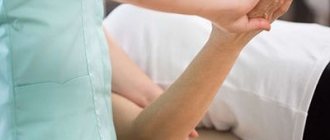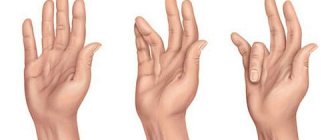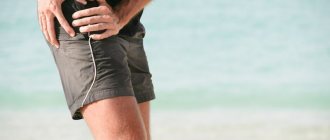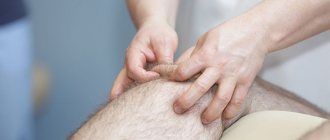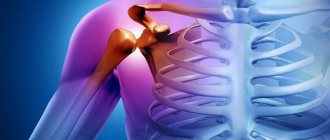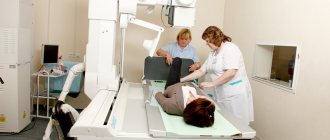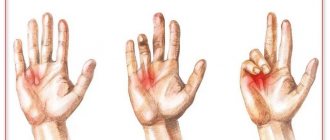Home > Fingers hurt
Dupuytren's contracture is a hand deformity that develops over the years. Pathological changes affect the palmar aponeurosis - a sheet of connective tissue under the skin of the palm. Nodules of tissue that form under the skin unite into a dense fibrous band and can pull one or more fingers into a permanently flexed position.
NB! Contracture of the fingers (a forced position with limited movement) is not always caused by palmar fibromatosis. Limitation of movement may be caused by trauma or neurological disorders.
The affected fingers do not fully extend, which makes everyday hand function difficult: difficulty putting your hand in a pocket, difficulty or impossible to put on gloves, difficulty shaking hands.
Dupuytren's contracture usually affects the ring or little finger and is more common in older men. A doctor has some tools in his arsenal that can make life easier for a person with Dupuytren's contracture.
Symptoms
The disease progresses slowly, usually over several years. Dupuytren's contracture begins with the appearance of lumps on the palm. Gradually, the skin wrinkles and characteristic indentations appear. You can feel a firm mass under the skin, which may be tender to the touch but is rarely painful.
In later stages of Dupuytren's contracture, strands of fibrous tissue from the palm extend to the fingers. As it progresses, these cords may curl the fingers toward the palm.
Most often this happens with the little finger or ring finger, but it also happens with the middle finger. The thumb and index finger are rarely involved in the pathological process.
/wp-content/uploads/2017/05/VID_20170601_123940.mp4
There are frequent cases of bilateral lesions. One hand is usually more involved than the other.
What is Dupuytren's disease
The name of the disease comes from the name of the surgeon Guillaume Dupuytren, who first described the disease. The word "contracture" means loss of joint mobility, that is, they cannot be bent or straightened. Needless to say that this greatly affects the quality of life?
In Dupuytren's syndrome, contracture occurs due to fibrous degeneration of the palmar aponeurosis - a wide tendon plate made of dense collagen and elastic fibers. As a rule, the disease affects the ring, middle and little fingers.
The fingers are firmly bent towards the palm, and various procedures are prescribed to straighten them. Unfortunately, this does not solve the problem: sooner or later the disease returns and affects new areas.
In addition, a person with Dupuytren's syndrome loses the ability to fine motor skills; in rare cases, the pathology is accompanied by unpleasant sensations and itching. But most often the process is painless and affects men over 40 years of age, and much less often women.
According to many experts, Dupuytren's contracture syndrome is hereditary and depends on the presence of a special gene. However, if your relative suffers from the disease, it is not a death sentence for you: many carriers of palmar fibromatosis (another name for the disease) never encounter it in their entire lives.
Risk factors
Although we do not know the exact cause, there are some factors associated with this pathology:
- Age. Dupuytren's contracture most often occurs after 50 years of age.
- Floor. Men are significantly more susceptible than women. Severe degrees of the disease are more common in men.
- Heredity and genetics. The disease is often inherited. Dupuytren's contracture is typical for residents of northern Europe.
- Tobacco and alcohol. Smoking increases the risk of developing Dupuytren's contracture, possibly due to capillary damage and chronic tissue ischemia. Alcohol abuse also worsens the prognosis.
- Diabetes. There are reports of an increase in the incidence of Dupuytren's contracture among diabetics.
Differential diagnosis
There are other diseases in which flexion contracture of the fingers develops and growths appear on the hand. Differential diagnosis for Dupuytren's disease:
- Corn.
- Epithelioid sarcoma.
- Hygroma.
- Stenosing tenosynovitis.
- Giant cell tumor of the tendon sheath.
- Damage to the flexor tendon.
- Ulnar nerve neuropathy.
- Camptodactyly.
- Fibromatosis and fibromas.
- Palmar (palmar) tendonitis.
Complications
Dupuytren's contracture impairs hand function. Since the thumb and index fingers are rarely used, many people cope with everyday tasks for quite a long time - with three fingers it is quite possible to write and pick up small objects. As it progresses, it becomes impossible to fully open the palm and grasp large objects (grasp) or fit the hand into narrow spaces (pockets). In later stages, dirt can accumulate in permanent folds of the skin and cause ulcers that will not heal.
How can I get my fingers to straighten again?
The answer is simple.
The red threads in the photograph imitate the cords of the palmar aponeurosis.
With cicatricial degeneration, the cords are shortened; a reduction in length of even a few centimeters leads to a pronounced limitation in the extension of the fingers.
In order for the fingers to straighten again, it is necessary to make the cords of the palmar aponeurosis elastic again or remove them altogether. It must be remembered that the aponeurosis is necessary for normal hand function, so its complete removal leads to a long recovery.
Preparation for inspection
Of course, you can show your hand to your local therapist or surgeon at the clinic. He will refer you to a hand surgery specialist.
Before the inspection, formulate answers to the following questions:
- Do your relatives have similar problems?
- What treatment have you already tried? How did this help?
- What medications do you use regularly?
The doctor will also ask you:
- How long ago did you notice the first symptoms?
- Does it get worse over time?
- Is there pain in your hand?
How much does contracture interfere with everyday life?
Treatment
Because the disease progresses slowly, is not painful, and is not always very bothersome, treatment may not be required. In the initial stages, observation may be sufficient. The palm-on-table test can be performed at home at some intervals.
Treatment consists of destroying or removing the cords that tighten the fingers. This can be done in several ways. The choice depends on the degree of contracture, comorbidities, and patient and surgeon preference. No matter how radical and categorical this may sound, at the moment Dupuytren’s contracture = surgery.
Forecast
When this pathology is detected, it is difficult to predict the nature of its further course, since it depends on the individual characteristics of each patient’s body. Thus, in one situation, a slight decrease in motor functionality can be observed for decades, in another, the rapid development of the disease is monitored.
In any case, the disease will certainly enter its final stage. In this case, the only effective way is to perform surgical intervention.
Needle technique
The fibrous cord can be crossed with an injection needle through punctures in the skin and the finger can be straightened. The contracture usually returns, then the procedure can be repeated.
The main advantage of needle (or needle) aponeurotomy is that there is no incision, and the operation can be performed on both arms at the same time.
Postoperative management is simple and the person quickly returns to normal activities. The main disadvantage is an earlier relapse and the possibility of damage to the nerve or tendon (which is extremely rare in reality).
Needle aponeurotomy can also be used for the staged treatment of severe Dupuytren's contracture. At the first stage, the fibrous cord is unbent with the help of punctures; as a rule, it is not possible to bring it into a straight position, but it is possible to transfer the 4th stage to the second. A person immediately becomes more comfortable using his hand. And after 5-6 months it is already possible to carry out a full-fledged open aponeurotomy and “adjust the finger.” This method allows you to speed up rehabilitation after surgery and reduce the risk of complications, because during the time between stages the skin has time to stretch, and the joints “remember” their normal range of motion.
Outcome assessment
Since flexion contracture of the fingers is one of the main disorders in Dupuytren's disease, range of motion should be measured at the metacarpophalangeal joints, proximal interphalangeal joints, and distal interphalangeal joints. It is necessary to measure active and passive flexion and extension. The data obtained will serve as the initial value. These measurements should be taken throughout the treatment process as they can also be used to determine the severity of contractures.
It is also important to assess the patient's hand function. To do this, you can use tests and questionnaires, such as DASH, or its shorter version, The Quick Dash. The DASH questionnaire is a 30-question questionnaire. It focuses on assessing function and symptoms in patients who have upper limb problems. Another hand and arm assessment tool is the Short Form-36. This is a 36-question questionnaire that is more general in nature and is used when working with various diseases. It can be useful in determining the patient's overall health and well-being.
Medication injections
Injecting drugs directly into fibrous tissue can soften or destroy it.
At the time of writing (May 2021), the situation in Russia is as follows:
Pfizer's drug Xiapex is not registered. It is the only collagenase in the world certified for the treatment of Dupuytren's contracture.
Collalysine is not certified for the treatment of Dupuytren's contracture, and I have never learned how to achieve the right concentration.
Fermenkol is at the stage of certification of the injection form.
Kenalog (not an enzyme, but a glucocorticoid) is certified for local injection and is an excellent softener for fibromatous nodes.
Operation
The fibrous cord can not only be cut under the skin, but also completely removed. The main advantage of open surgery is the most complete and long-lasting effect compared to closed methods.
The main disadvantage of a full-fledged operation is the longer recovery. The sutures are removed after 2 weeks and the same or even more may be needed to restore function.
In any case, no matter what treatment method we choose, I have no reason to admit the patient to the hospital. Any treatment for Dupuytren's contracture can be performed on an outpatient basis using local anesthesia (unless, of course, you are allergic to local anesthetics).
Treatment after surgery
Immediately after suturing the skin, a large sterile bandage is applied, and the hand is placed on a scarf. During the first day, a lot of blood is usually released, so I always wrap a thick “mitten” around my hand. For the first 2-3 days, the hand should be held higher, trying not to lower it below the level of the heart. As soon as the anesthesia wears off (which is 3-4 hours after surgery), you should take painkillers.
Before the stitches are removed, we will meet several times, gradually your “mitten” will become thinner, and your arm will hurt less and less. After 2 weeks, the stitches are removed. It does not hurt! Sometimes it happens that the bandage remains on the arm even after the stitches are removed. With severe contracture, marginal necrosis of the flaps and longer healing of the transverse approach are possible.
After the wound has healed, you can wash your hand and start using it. Under the scars, the skin is initially hard and inactive. It needs to be softened with massage, hand cream, movements and physiotherapeutic procedures.
NB! Classes with a hand therapist improve the results of treatment of Dupuytren's contracture.
Plaster and other means of immobilization are used very rarely, only in special cases.
Full restoration of hand mobility after open aponeurotomy should be expected no earlier than 2 months.
Stages of Dupuytren's contracture
Like any other disease, Dupuytren's palmar fascial fibromatosis occurs in several stages:
- A small nodule appears in place of one of the tendons , which people tend to consider a callus. It doesn’t bother me in any way and the joints still retain the same mobility.
- The nodule develops into a scar cord and passes to the proximal digital phalanx. The skin in the area of the scar cord becomes rough and red, the finger bends at an angle of 30 degrees and loses mobility.
- The disease spreads over the entire finger , the skin on it becomes wrinkled and folded, and the finger itself bends 90 degrees, contracture of the entire hand is observed. At this stage, fusion of the joint surfaces is already possible, in other words - ankylosis.
- Adjacent fingers are affected, sometimes the entire palm. Often they grow together into a single large scar, with the first affected finger at a 90-degree angle, and the rest severely deformed. The palm may be dislocated, and the patient feels aching pain in the deformed areas.
There is no discomfort until the last stage, and it is rare for the disease to progress that far. In the first stages, it can only be detected visually, so diagnosing the problem is possible only with a person’s attentive attitude to health.
